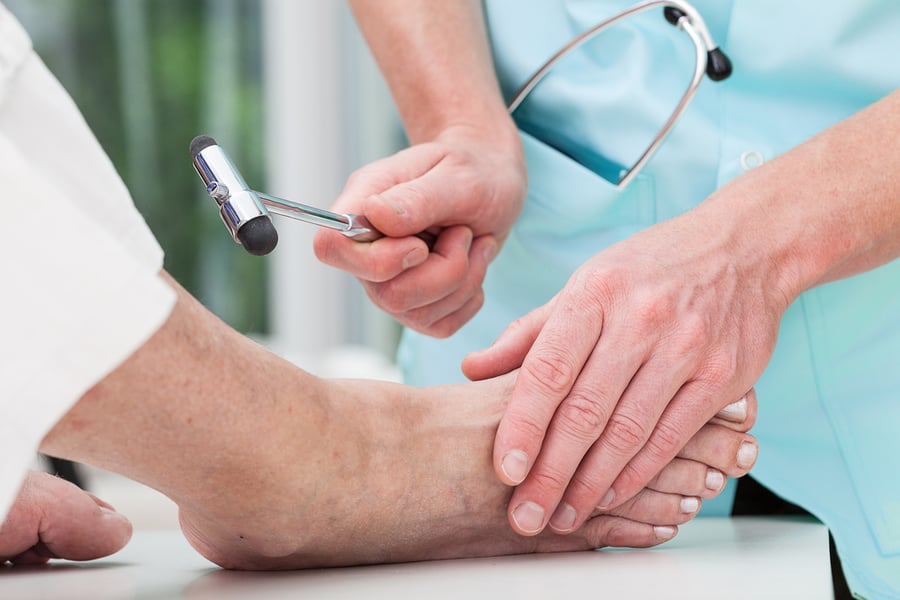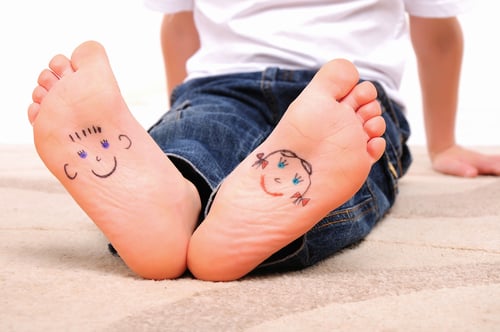
If you consider the human foot, it really is a marvel of biomechanical engineering with each foot containing 26 bones, 33 joints, and over 100 muscles, tendons, and ligaments.
“Our feet need to be strong enough to deal with some of the greatest forces experienced by the body, whilst also being capable of movements as exquisite as a ballerina's pirouette,” said Dr. George McGavin, BBC presenter.
The foot contains nearly one-quarter of all bones in your body, has more nerves per square centimeter than any other part of your body, has the longest and strongest tendon in your body, and is sturdy enough to take the force of five times your body weight when you run.
“Your feet are complex and hard-working body parts,” says the Cleveland Clinic.
The daily use, and abuse, of our feet can lead to a host of problems, especially during the pandemic when foot and ankle specialists saw an increase in patients with foot pain by as much as 20 to 30 percent (a phenomenon known as “pandemic foot”).
Some of the More Common Foot Ailments
When it comes to foot pain or ailments, here are some of the most common foot diseases that could be causing them:
- Athlete's Foot (Tinea Pedis):
o Symptoms: Itchy, red, scaly rash on the foot, usually between the toes. The skin may become cracked and painful.
o Causes: Fungal infection, often spread in damp and communal areas like locker rooms and swimming pools.
o Treatment: Over-the-counter antifungal creams, powders, or sprays. Severe cases may require prescription medication.
- Plantar Fasciitis:
o Symptoms: Sharp, stabbing pain in the heel or bottom of the foot, especially after periods of inactivity or walking.
o Causes: Inflammation of the plantar fascia, a thick band of tissue that connects the heel bone to the toes. Often caused by excessive strain, flat feet, or improper footwear.
o Treatment: Rest, stretching exercises, orthotic shoe inserts, pain relief medications, and physical therapy. Severe cases may require corticosteroid injections or even surgery.
- Ingrown Toenails:
o Symptoms: Pain, redness, and swelling along the side of the toenail. The nail may grow into the skin, causing infection.
o Causes: Improper toenail trimming, tight-fitting shoes, injury, or hereditary factors.
o Treatment: Soaking the foot, gently lifting the ingrown edge of the nail, wearing open-toed shoes, and keeping the area clean. In severe cases, a doctor may need to remove part of the nail or perform surgery.
- Bunions:
o Symptoms: A bony bump at the base of the big toe, often accompanied by pain, redness, and swelling. The big toe may point toward the other toes.
o Causes: Genetics, wearing tight or narrow shoes, and foot structure issues.
o Treatment: Wearing roomier shoes, using orthotic inserts, pain relief medications, and applying ice. Severe cases may require surgery to remove the bunion.
- Corns and Calluses:
o Symptoms: Thick, hardened layers of skin that develop in response to friction or pressure. Corns are usually small and localized, while calluses are larger and spread out.
o Causes: Repeated friction or pressure on the skin, often due to ill-fitting shoes or foot deformities.
o Treatment: Soaking the feet, using pumice stones to gently remove dead skin, applying moisturizers, and wearing properly fitting shoes. Severe cases may need professional treatment.
Foot Diseases: Arthritic Foot Conditions
There are several arthritic foot diseases and conditions that can affect the feet, including:
- Charcot Foot (Charcot Arthropathy):
o Symptoms: Swelling, redness, and warmth in the foot. The foot may become misshapen and lose its normal arch. Pain might not be as intense due to nerve damage.
o Causes: Often seen in people with neuropathy (nerve damage) caused by conditions like diabetes. Nerve damage can lead to loss of sensation and the ability to detect injury.
o Treatment: Immobilization of the foot with casts, braces, or walking boots to allow for healing. In severe cases, surgery might be necessary to correct deformities or stabilize the foot.
- Gout:
o Symptoms: Intense pain, redness, swelling, and warmth in the affected joint (often the big toe). Gout attacks usually occur suddenly and are extremely painful.
o Causes: Gout is caused by the buildup of uric acid crystals in a joint. Diet, genetics, obesity, and certain medical conditions can contribute to elevated uric acid levels.
o Treatment: Medications to relieve pain and reduce inflammation during acute attacks. Long-term management involves lifestyle changes (such as diet modifications to reduce purine intake) and medications to lower uric acid levels.
- Rheumatoid Arthritis:
o Symptoms: Joint pain, swelling, stiffness, and tenderness. In the feet, it can cause deformities like bunions, hammertoes, and inflammation of the joints.
o Causes: Rheumatoid arthritis is an autoimmune disorder where the body's immune system attacks its own joints, leading to inflammation and damage.
o Treatment: Medications to reduce inflammation and suppress the immune response. Physical therapy, orthotic devices, and in some cases, surgery to correct deformities.
- Osteoarthritis:
o Symptoms: Joint pain, stiffness, and reduced range of motion. In the feet, it can affect joints such as the ankles and toes.
o Causes: Osteoarthritis is caused by the breakdown of cartilage in joints over time, often due to wear and tear.
o Treatment: Pain relief medications, physical therapy, orthotic devices, and lifestyle changes to manage symptoms. In severe cases, joint replacement surgery might be considered.
- Psoriatic Arthritis:
o Symptoms: Joint pain, swelling, and stiffness, often associated with skin symptoms like psoriasis. It can affect various joints, including those in the feet.
o Causes: Psoriatic arthritis is an autoimmune condition that occurs in people with psoriasis, where the immune system attacks the joints and skin.
o Treatment: Medications to reduce inflammation and manage symptoms, as well as lifestyle modifications.
Foot Diseases: Cancer of the Foot
Cancers of the foot, while relatively rare, can occur like any other part of the body. Here are a few types of foot cancers:
- Kaposi Sarcoma:
o Kaposi sarcoma is a type of cancer that affects the blood vessels and connective tissues. It often appears as purple or red lesions on the skin or mucous membranes, and it can affect various parts of the body, including the feet.
o Kaposi sarcoma is most seen in people with weakened immune systems, such as those with HIV/AIDS. It can also occur in people of Mediterranean, African, or Eastern European descent.
o Treatment may involve addressing the underlying immune deficiency (if applicable), radiation therapy, chemotherapy, and other targeted treatments.
- Squamous Cell Carcinoma:
o Squamous cell carcinoma is a type of skin cancer that can develop on the feet, particularly on the soles. It often appears as scaly or crusty areas, ulcers, or raised growths that can be painful.
o Long-term sun exposure, chronic wounds, and certain environmental factors can increase the risk of squamous cell carcinoma.
o Treatment typically involves surgical removal of the cancerous tissue. In some cases, radiation therapy or topical treatments may be used.
- Melanoma:
o Melanoma is a type of skin cancer that can occur on the feet. It can develop in existing moles or as new growths, and it might look like an irregularly shaped, dark-colored lesion.
o Risk factors for melanoma include sun exposure, history of sunburns, family history of melanoma, and certain genetic factors.
o Treatment involves surgical removal of the melanoma, along with additional therapies depending on the stage and severity of the cancer.
- Soft Tissue Sarcoma:
o Soft tissue sarcomas are cancer that arise in the soft tissues, including muscles, tendons, and connective tissues. They can develop in the feet as well.
o Symptoms might include a lump or mass, pain, or limited mobility in the affected area.
o Treatment typically involves surgical removal of the tumor, followed by radiation therapy or chemotherapy, depending on the type and stage of the sarcoma.
- Bone Sarcoma:
o Bone sarcomas can develop in the bones of the foot. These cancers often cause pain, swelling, and changes in the affected bone's structure.
o Treatment usually includes surgical removal of the tumor, followed by chemotherapy or radiation therapy. In some cases, amputation might be necessary.
Other Types of Foot Diseases
Just as the foot has many facets to its design, there are other types of foot diseases that can affect patients such as:
- Freiberg's Disease (Freiberg Infraction):
o Freiberg's Disease is a condition that primarily affects the metatarsal bones, usually the second metatarsal. It involves the death of a portion of the bone due to a lack of blood supply, leading to pain and possible joint deformity.
o Symptoms include pain, swelling, and limited joint movement in the affected area.
o Treatment involves reducing stress on the affected area, often through rest, immobilization, and custom orthotic devices. In some cases, surgery may be necessary to address joint damage.
- Maffucci's Syndrome:
o Maffucci's Syndrome is a rare disorder characterized by the presence of multiple enchondromas (benign cartilage tumors) in bones, often accompanied by hemangiomas (benign blood vessel tumors) in the skin.
o In the feet, these tumors can lead to bone deformities and pain.
o Treatment depends on the severity and location of tumors, and it may involve surgical removal or other interventions to address complications.
- Raynaud's Disease (Raynaud's Phenomenon):
o Raynaud's Disease is a condition that affects blood flow to the extremities, such as the fingers and toes. It causes episodes of reduced blood circulation, leading to color changes in the skin (white, blue, then red), along with coldness, numbness, and tingling.
o While Raynaud's primarily affects the fingers and toes, it can also impact the feet.
o Treatment involves avoiding triggers (such as cold temperatures and stress), keeping warm, and, in some cases, medications to improve blood circulation.
- Sever's Disease (Calcaneal Apophysitis):
o Sever's Disease is a common condition in growing children and adolescents. It involves inflammation of the growth plate in the heel bone (calcaneus).
o Symptoms include heel pain, especially during physical activities. It's often associated with rapid growth and increased physical activity.
o Treatment involves rest, ice, stretching exercises, and supportive footwear. Most cases resolve with time as the growth plate matures.
It's important to note that proper diagnosis and treatment of foot conditions should be provided by a qualified healthcare professional. If you suspect you have any of these conditions or are experiencing foot pain or discomfort, seek medical advice for accurate assessment and guidance.






